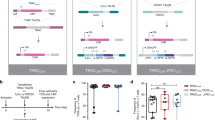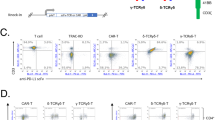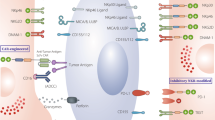Abstract
Chimeric antigen receptors (CARs, immunoreceptors) are frequently used to redirect T cells with pre-defined specificity, in particular towards tumour cells for use in adoptive immunotherapy of malignant diseases. Specific targeting is mediated by an extracellularly located antibody-derived binding domain, which is joined to the transmembrane and intracellular CD3ζ moiety for T-cell activation. Stable CAR expression in T cells, however, requires a spacer domain interposed between the binding and the transmembrane domain and which is commonly the constant IgG1 Fc domain. We here revealed that CARs with Fc spacer domain bind to IgG Fc gamma receptors (FcγRs), thereby unintentionally activating innate immune cells, including monocytes and natural killer (NK) cells, which consequently secrete high amounts of pro-inflammatory cytokines. Engineered T cells, on the other hand, are likewise activated by FcγR binding resulting in cytokine secretion and lysis of monocytes and NK cells independently of the redirected specificity. To reduce FcγR binding, we modified the spacer domain without affecting CAR expression and antigen binding. Engineered with the modified CAR, T cells are not activated in presence of FcγR+ cells, thereby minimizing the risk of off-target activation while preserving their redirected targeting specificity.
This is a preview of subscription content, access via your institution
Access options
Subscribe to this journal
Receive 12 print issues and online access
$259.00 per year
only $21.58 per issue
Buy this article
- Purchase on Springer Link
- Instant access to full article PDF
Prices may be subject to local taxes which are calculated during checkout





Similar content being viewed by others
References
Johnson LA, Morgan RA, Dudley ME, Cassard L, Yang JC, Hughes MS et al. Gene therapy with human and mouse T-cell receptors mediates cancer regression and targets normal tissues expressing cognate antigen. Blood 2009; 114: 535–546.
Kershaw MH, Westwood JA, Parker LL, Wang G, Eshhar Z, Mavroukakis SA et al. A phase I study on adoptive immunotherapy using gene-modified T cells for ovarian cancer. Clin Cancer Res 2006; 12: 6106–6115.
Lamers CHJ, Sleijfer S, Vulto AG, Kruit WHJ, Kliffen M, Debets R et al. Treatment of metastatic renal cell carcinoma with autologous T-lymphocytes genetically retargeted against carbonic anhydrase IX: first clinical experience. J Clin Oncol 2006; 24: e20–e22.
Yaghoubi SS, Jensen MC, Satyamurthy N, Budhiraja S, Paik D, Czernin J et al. Noninvasive detection of therapeutic cytolytic T cells with 18F-FHBG PET in a patient with glioma. Nat Clin Pract Oncol 2009; 6: 53–58.
Eshhar Z . The T-body approach: redirecting T cells with antibody specificity. Handb Exp Pharmacol 2008; 181: 329–342.
Abken H, Hombach A, Heuser C . Immune response manipulation: recombinant immunoreceptors endow T-cells with predefined specificity. Curr Pharm Des 2003; 9: 1992–2001.
Moritz D, Groner B . A spacer region between the single chain antibody- and the CD3 zeta-chain domain of chimeric T cell receptor components is required for efficient ligand binding and signaling activity. Gene Ther 1995; 2: 539–546.
Guest RD, Hawkins RE, Kirillova N, Cheadle EJ, Arnold J, O’Neill A et al. The role of extracellular spacer regions in the optimal design of chimeric immune receptors: evaluation of four different scFvs and antigens. J Immunother 2005; 28: 203–211.
Shields RL, Namenuk AK, Hong K, Meng YG, Rae J, Briggs J et al. High resolution mapping of the binding site on human IgG1 for Fc gamma RI, Fc gamma RII, Fc gamma RIII, and FcRn and design of IgG1 variants with improved binding to the Fc gamma R. J Biol Chem 2001; 276: 6591–6604.
Armour KL, van de Winkel JGJ, Williamson LM, Clark MR . Differential binding to human FcgammaRIIa and FcgammaRIIb receptors by human IgG wildtype and mutant antibodies. Mol Immunol 2003; 40: 585–593.
Armour KL, Clark MR, Hadley AG, Williamson LM . Recombinant human IgG molecules lacking Fcgamma receptor I binding and monocyte triggering activities. Eur J Immunol 1999; 29: 2613–2624.
Park JR, Digiusto DL, Slovak M, Wright C, Naranjo A, Wagner J et al. Adoptive transfer of chimeric antigen receptor re-directed cytolytic T lymphocyte clones in patients with neuroblastoma. Mol Ther 2007; 15: 825–833.
Gonzalez S, Naranjo A, Serrano LM, Chang W, Wright CL, Jensen MC . Genetic engineering of cytolytic T lymphocytes for adoptive T-cell therapy of neuroblastoma. J Gene Med 2004; 6: 704–711.
Muranski P, Boni A, Wrzesinski C, Citrin DE, Rosenberg SA, Childs R et al. Increased intensity lymphodepletion and adoptive immunotherapy--how far can we go? Nat Clin Pract Oncol 2006; 3: 668–681.
Weijtens ME, Willemsen RA, Hart EH, Bolhuis RL . A retroviral vector system ‘STITCH’ in combination with an optimized single chain antibody chimeric receptor gene structure allows efficient gene transduction and expression in human T lymphocytes. Gene Ther 1998; 5: 1195–1203.
Wolf J, Kapp U, Bohlen H, Kornacker M, Schoch C, Stahl B et al. Peripheral blood mononuclear cells of a patient with advanced Hodgkin's lymphoma give rise to permanently growing Hodgkin-Reed Sternberg cells. Blood 1996; 87: 3418–3428.
Schwegler C, Dorn-Beineke A, Nittka S, Stocking C, Neumaier M . Monoclonal anti-idiotype antibody 6G6.C4 fused to GM-CSF is capable of breaking tolerance to carcinoembryonic antigen (CEA) in CEA-transgenic mice. Cancer Res 2005; 65: 1925–1933.
Pohl C, Renner C, Schwonzen M, Schobert I, Liebenberg V, Jung W et al. CD30-specific AB1-AB2-AB3 internal image antibody network: potential use as anti-idiotype vaccine against Hodgkin's lymphoma. Int J Cancer 1993; 54: 418–425.
Willemsen RA, Weijtens ME, Ronteltap C, Eshhar Z, Gratama JW, Chames P et al. Grafting primary human T lymphocytes with cancer-specific chimeric single chain and two chain TCR. Gene Ther 2000; 7: 1369–1377.
Hombach A, Schneider C, Sent D, Koch D, Willemsen RA, Diehl V et al. An entirely humanized CD3 zeta-chain signaling receptor that directs peripheral blood t cells to specific lysis of carcinoembryonic antigen-positive tumor cells. Int J Cancer 2000; 88: 115–120.
Hombach A, Sent D, Schneider C, Heuser C, Koch D, Pohl C et al. T-cell activation by recombinant receptors: CD28 costimulation is required for interleukin 2 secretion and receptor-mediated T-cell proliferation but does not affect receptor-mediated target cell lysis. Cancer Res 2001; 61: 1976–1982.
Weijtens ME, Hart EH, Bolhuis RL . Functional balance between T cell chimeric receptor density and tumor associated antigen density: CTL mediated cytolysis and lymphokine production. Gene Ther 2000; 7: 35–42.
Jost LM, Kirkwood JM, Whiteside TL . Improved short- and long-term XTT-based colorimetric cellular cytotoxicity assay for melanoma and other tumor cells. J Immunol Methods 1992; 147: 153–165.
Acknowledgements
We thank Birgit Hops and Frank Steiger for technical assistance. Our work was supported by a grant from the Deutsche Krebshilfe, Bonn, the ATTACK consortium funded by the European Community and the Fortune programme of the Medical Faculty, University of Cologne.
Author information
Authors and Affiliations
Corresponding author
Ethics declarations
Competing interests
The authors declare no conflict of interest.
Rights and permissions
About this article
Cite this article
Hombach, A., Hombach, A. & Abken, H. Adoptive immunotherapy with genetically engineered T cells: modification of the IgG1 Fc ‘spacer’ domain in the extracellular moiety of chimeric antigen receptors avoids ‘off-target’ activation and unintended initiation of an innate immune response. Gene Ther 17, 1206–1213 (2010). https://doi.org/10.1038/gt.2010.91
Received:
Revised:
Accepted:
Published:
Issue Date:
DOI: https://doi.org/10.1038/gt.2010.91
Keywords
This article is cited by
-
New cell sources for CAR-based immunotherapy
Biomarker Research (2023)
-
Challenges and new technologies in adoptive cell therapy
Journal of Hematology & Oncology (2023)
-
Complexities in comparing the impact of costimulatory domains on approved CD19 CAR functionality
Journal of Translational Medicine (2023)
-
CAR-T cell potency: from structural elements to vector backbone components
Biomarker Research (2022)
-
Activation-induced cell death in CAR-T cell therapy
Human Cell (2022)



